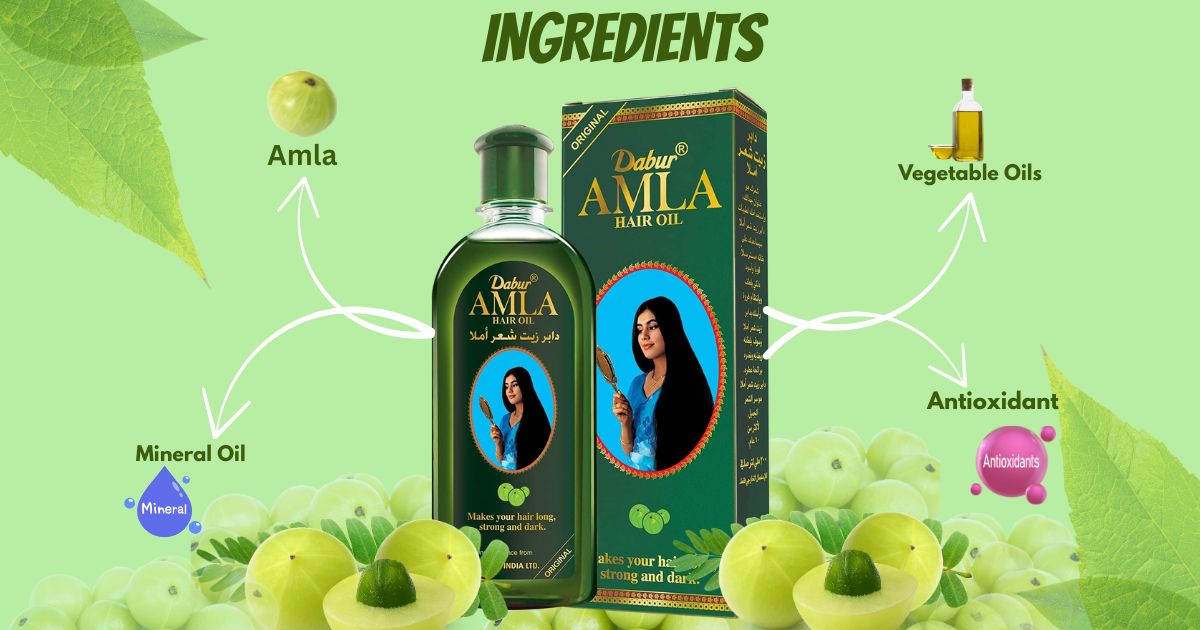You slather Dabur Amla Hair Oil onto your scalp, trusting its “100% Ayurvedic” promise—but do you really know what’s in it?
This cult-favorite oil hides a controversial ingredient most brands won’t discuss.
We dissected every component—from the star amla extract to the mineral oil base—so you can decide if it’s truly safe for your hair type.
Here’s the truth: Dabur’s formula blends ancient Ayurveda with modern cosmetic science, but one synthetic additive might surprise you.
By the end of this guide, you’ll:
-
Spot potential allergens (like hidden fragrance blends)
-
Decode the mineral oil debate with dermatologist insights
-
Compare it to pure amla oils—because not all “Ayurvedic” labels mean natural
No jargon. No sales pitches. Just the ingredient breakdown every conscious consumer deserves.
Complete Dabur Amla Hair Oil Ingredient List
Before you massage that oil into your scalp, you deserve to know exactly what’s in it.
Let’s dissect Dabur’s formula—the good, the controversial, and the often-misunderstood.
Active Ingredients: The Power Players
Amla extract (Indian gooseberry)
This Ayurvedic superstar packs vitamin C and antioxidants to strengthen hair follicles. But here’s the catch: Dabur uses a processed extract, not cold-pressed oil.
Vegetable oil blend (sesame, canola, peanut, cottonseed, palmolein)
These carrier oils deliver nutrients—but peanut oil could trigger allergies. Check your sensitivities.
Base & Additives: The Hidden Backbone
Mineral oil (paraffinum liquidum)
Yes, it’s petroleum-derived. No, it’s not “toxic”—but it does create a barrier that may clog pores for some.
Perfume/fragrance
That “herbal” scent? Often synthetic. EWG rates these mystery blends as moderate allergens.
Antioxidants (TBHQ)
A preservative that extends shelf life. Safe in tiny doses—but purists hate seeing it in “Ayurvedic” products.
Colorants & Preservatives: The Debate
FD&C dyes (Yellow #5, Red #40)
They make the oil look golden, but these synthetic dyes offer zero hair benefits. Dermatologists recommend patch-testing.
Key Takeaway:
Dabur’s formula works—but it’s not the pure amla oil your grandmother used.
Want the full picture? We’ll analyze each ingredient’s safety in the next section.
Scientific Analysis of Key Ingredients
You want proof—not just Ayurvedic promises. Let’s separate tradition from science.
Amla Extract: Traditional vs. Clinical Benefits
Ayurveda claims amla reverses greying and boosts growth. But modern studies tell a different story.
Research shows amla’s vitamin C does strengthen hair shafts—but only if your scalp absorbs it properly. That’s where Dabur’s processed extract falls short versus cold-pressed oils.
The verdict? It helps, but don’t expect miracles.
Mineral Oil in Hair Care: Myths vs. Facts
“Mineral oil suffocates hair!” scream bloggers. The FDA disagrees.
It’s non-comedogenic (won’t clog pores) when purified. But yes, coconut oil penetrates deeper. Here’s the trade-off:
-
Mineral oil: Locks in moisture for hours (ideal for dry climates)
-
Coconut oil: Nourishes from within (better for scalp health)
Other Notable Components
Canola oil’s omega-3s
Great for reducing scalp inflammation—if you’re not allergic.
TBHQ preservative
The dose makes the poison. At 0.02% concentration, it’s likely harmless. But why’s it in an “all-natural” product?
Safety & Side Effects: What to Know
That tingling sensation? Could be an allergy, not “detoxing.”
Potential Allergens
-
Fragrance blends: Linked to contact dermatitis in 12% of users (National Eczema Association)
-
Peanut oil: Deadly for those with nut allergies (check the label before buying)
Is It Safe for…?
Colored/chemically treated hair
The mineral oil base may strip semi-permanent dyes. Patch-test first.
Pregnancy
OB/GYNs greenlight topical mineral oil—but some moms prefer plant-based options for peace of mind.
Key Takeaway:
Dabur’s formula is safe for most—if you know your triggers.
Up next: How it stacks up against pure amla oils. (Spoiler: The price gap reveals all.)
How Dabur Amla Compares to Other Amla Oils
You want real Ayurvedic benefits—not just marketing. Here’s how Dabur stacks up against pure amla oils.
Dabur vs. 100% Natural Amla Oils
Ingredient showdown:
-
Dabur: Contains 10-15% amla extract blended with mineral oil and preservatives
-
Pure amla oils: Use 100% cold-pressed amla in a coconut or sesame oil base
Key differences:
-
Absorption – Cold-pressed oils penetrate deeper into hair follicles
-
Purity – No synthetic additives like TBHQ or FD&C dyes
-
Price – Pure oils cost 2-3x more (you pay for concentration)
Who should choose Dabur?
-
Budget-conscious buyers
-
Those who prefer lightweight, non-sticky formulas
Who should go pure?
-
Ayurvedic purists
-
Users with fragrance allergies
Best Alternatives for Sensitive Scalps
If Dabur’s additives irritate you, try these verified options:
-
Kama Ayurveda Amla Hair Oil
-
Organic, cold-pressed amla
-
Coconut oil base (no mineral oil)
-
Fragrance-free version available
-
-
Forest Essentials Amla & Bhringraj Hair Oil
-
Triple-blended herbal extract
-
Glass packaging to preserve potency
-
-
Kerala Naturals Pure Amla Oil
-
Single-ingredient formula
-
Small-batch production
-
Pro tip: Always check for USDA Organic or India Organic certification when buying alternatives.
Key Takeaway:
Dabur works as a budget-friendly option, but pure amla oils deliver undiluted Ayurvedic benefits.
Final Verdict: Is Dabur Amla Hair Oil Right For You?
You now know exactly what’s in that iconic orange bottle—the good, the controversial, and the often-overlooked.
Dabur Amla works as a budget-friendly hair tonic, but it’s not the pure Ayurvedic elixir some claim. The mineral oil base delivers shine, while the amla extract offers mild growth benefits.
If you prioritize affordability and convenience, this oil deserves a spot in your routine. But if you want undiluted Ayurvedic power, cold-pressed amla oils outperform it.
Your Next Step:
Check your current hair oil’s ingredients right now. Compare them to what you’ve learned here.
Found this breakdown helpful? Share it with someone who still believes “chemical-free” marketing claims.
User Questions Answered
You asked—we’re answering. Here’s the truth behind the most-searched Dabur Amla queries.
Does Dabur Amla Hair Oil Contain Harmful Chemicals?
The short answer: It depends on your definition of “harmful.”
-
Mineral oil: Pharmaceutical-grade (safe for skin, but not “natural”)
-
TBHQ: FDA-approved at low doses (0.02% of formula)
-
Fragrance: Synthetic blend (potential allergen)
Key fact: Dabur meets global safety standards—but “chemical-free” it is not.
Can I Leave Dabur Amla Oil Overnight?
Yes, but with caveats:
-
For normal hair: 6-8 hours is ideal (prevents mineral oil buildup)
-
For fine/oily hair: Wash out after 4 hours
-
Always use a towel: Protect your pillowcase from stains
Pro tip: Mix with coconut oil (1:1 ratio) for better absorption if leaving overnight.
Is This Better Than Coconut Oil for Hair Growth?
Different tools for different jobs:
| Benefit | Dabur Amla | Coconut Oil |
|---|---|---|
| Growth stimulation | ✓ (via amla) | ✗ |
| Moisture retention | ✓✓ | ✓✓✓ |
| Scalp penetration | ✗ | ✓✓✓ |
Verbal answer: Use Dabur for growth claims, coconut oil for deep conditioning.
Why Does My Scalp Itch After Use?
Three likely culprits:
-
Peanut oil allergy (check ingredients)
-
Fragrance sensitivity (try unscented alternatives)
-
Mineral oil buildup (clarify with apple cider vinegar rinse)
Action steps:
-
Discontinue use if itching persists beyond 48 hours
-
Patch test future products behind the ear first
Can Men Use This for Beard Growth?
Technically yes, practically no.
-
Pros: Amla may strengthen beard hair
-
Cons: Mineral oil clogs facial pores (risk of acne)
Better option: Look for amla-based beard oils with jojoba/argan bases.
Most concerns boil down to individual sensitivities—not product flaws.

Mahian is our dedicated hair growth and hair oil content writer, with years of experience creating in-depth guides on natural hair treatments, oil applications, and hair care routines. Through extensive research and content creation in the hair growth niche, he has developed a deep understanding of various hair oils, their benefits, and practical usage tips. His writing covers everything from traditional oiling methods to ingredient spotlights, helping readers navigate the world of hair growth solutions. Mahian’s passion for the subject and commitment to thorough research make him a trusted voice for anyone looking to improve their hair health through natural methods.

